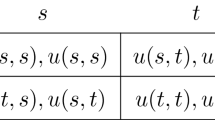Abstract
This paper introduces a class of games, called unit-sphere games, in which strategies are real vectors with unit 2-norms (or, on a unit-sphere). As a result, they should no longer be interpreted as probability distributions over actions, but rather be thought of as allocations of one unit of resource to actions and the payoff effect on each action is proportional to the square root of the amount of resource allocated to that action. The new definition generates a number of interesting consequences. We first characterize the sufficient and necessary condition under which a two-player unit-sphere game has a Nash equilibrium. The characterization reduces solving a unit-sphere game to finding all eigenvalues and eigenvectors of the product matrix of individual payoff matrices. For any unit-sphere game with non-negative payoff matrices, there always exists a unique Nash equilibrium; furthermore, the unique equilibrium is efficiently reachable via Cournot adjustment. In addition, we show that any equilibrium in positive unit-sphere games corresponds to approximate equilibria in the corresponding normal-form games. Analogous but weaker results are obtained in n-player unit-sphere games.
Similar content being viewed by others
Notes
According to certain existing empirical evaluations (see Agarwal et al. 2011), the CTR of an ad link is concave in payment, where the degree of concavity depends on the keyword length. In our example, the CTR is proportional to the square root of the money spent, which is one special and commonly used concave function. In fact, it is standard to assume that the cost of a certain amount of “effort” e (e.g., CTR in our example) is proportional to \(e^2\). See Holmstrom and Milgrom (1987), Hauser et al. (1994), Lafontaine and Slade (1996) and Hu et al. (2015).
In cases where \(Ay = 0\) (resp. \(Bx = 0\)), one may set \(\alpha \) (resp. \(\beta \)) arbitrarily.
We say a matrix \(A > 0\) if \(A_{ij} > 0\) for all (i, j), and a vector \(x \ge 0\) if \(x_i \ge 0\) for all i.
Recall that \(\rho (AB) = \rho (BA)\).
Linear convergence is another way of saying the error diminishes exponentially fast in the number of iterations.
A multiplicative k-approximate MSNE denotes a strategy profile where no player can improve her utility by k times via deviation.
References
Agarwal A, Hosanagar K, Smith MD (2011) Location, location, location: an analysis of profitability of position in online advertising markets. J Market Res 48(6):1057–1073
Berman A, Plemmons RJ (1979) Nonnegative matrices in the mathematical sciences. Academic Press, London
Chang KC, Pearson Kelly J, Zhang Tan (2013) Some variational principles for z-eigenvalues of nonnegative tensors. Linear Algebra Appl 438(11):4166–4182
Chen X, Deng X (2006) Settling the complexity of two-player nash equilibrium. FOCS 6:261–272
Fiat A, Papadimitriou CH (2010) When the players are not expectation maximizers. In: Algorithmic game theory—third international symposium, SAGT 2010, Athens, Greece, October 18–20, 2010. Proceedings, pp 1–14
Hauser JR, Simester DI, Wernerfelt B (1994) Customer satisfaction incentives. Market Sci 13(4):327–350
Holmstron B, Milgrom P (1987) Aggregation and linearity in the provision of intertemporal incentives. Econometr J Econ Soc 55(2):303–328
Hu Y, Shin J, Tang Z (2015) Incentive problems in performance-based online advertising pricing: cost per click vs. cost per action. Manag Sci 62(7):2022–2038
Kolda TG, Mayo JR (2011) Shifted power method for computing tensor eigenpairs. SIAM J Matrix Anal Appl 32(4):1095–1124
Lafontaine F, Slade ME (1996) Retail contracting and costly monitoring: theory and evidence. Eur Econ Rev 40(3):923–932
Li W, Ng MK (2014) On the limiting probability distribution of a transition probability tensor. Linear Multilinear Algebra 62(3):362–385
Mises RV, Pollaczek-Geiringer H (1929) Praktische verfahren der gleichungsauflösung. ZAMM J Appl Math Mechanics/Zeitschrift für Angewandte Mathematik und Mechanik 9(1):58–77
Roberson B (2006) The colonel blotto game. Econ Theory 29(1):1–24
Sorensen DC (2002) Numerical methods for large eigenvalue problems. Acta Numerica 11:519–584
Acknowledgements
We are grateful to Andrew Yao for helpful discussions. Part of this work is done while Pingzhong Tang was visiting Simons institute at UC Berkeley. This work was supported by the National Basic Research Program of China Grant 2011CBA00300, 2011CBA00301, the Natural Science Foundation of China Grant 61033001, 61361136003, 61303077, 61561146398, a Tsinghua Initiative Scientific Research Grant and a China Youth 1000-talent program.
Author information
Authors and Affiliations
Corresponding author
Rights and permissions
About this article
Cite this article
Tang, P., Zhang, H. Unit-sphere games. Int J Game Theory 46, 957–974 (2017). https://doi.org/10.1007/s00182-017-0565-y
Accepted:
Published:
Issue Date:
DOI: https://doi.org/10.1007/s00182-017-0565-y



